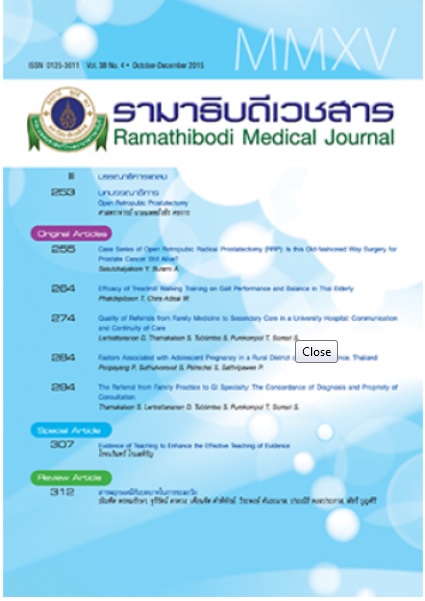Quality of Referrals from Family Medicine to Secondary Care in a University Hospital: Communication and Continuity of Care
Keywords:
Referral, Quality, Communication, Continuity of care, Family physician, Secondary careAbstract
Objective: To study the quality of referrals made from Family Medicine Department to Secondary Care Medicine atRamathibodi Hospital, Bangkok.
Methods: Cross-sectional descriptive study. Of 2,714 patients who were referred between 1 January and 31 December 2010, 483 patients were sampled and reviewed.
Results: About 80% of the referrals were made to 6 subspecialties: gastroenterology (21.95%), cardiology (17.18%), neurology (13.87%), pulmonology (11.59%), endocrinology (8.7%) and nephrology (7.87%). Consultations were done in 87.78% of the referrals. The mean waiting time was 18.27 days. 82.23% did not record a reason for referral and 13.22% did not make the referring problem clear. About 20 percent of referrals were made too early. Feedback from a specialist was provided in only 14.08% of cases. And only 3.73% of patients were sent back to family physicians. The retrospective review suggested that 23.6% of cases could have been managed by family physicians.
Conclusions: Several problems regarding quality of referrals were identified. Referral form and structured feedback from specialists should be introduced. One in four referrals could potentially be avoided by developing guidelines for managing commonly referred problems and by strengthening the knowledge of family physicians and residents through training programs.
References
Kripalani S, LeFevre F, Phillips CO, Williams MV, Basaviah P, Baker DW. Deficits in communication and information transfer between hospital-based and primary care physicians: implications for patient safety and continuity of care. JAMA. 2007;297(8):831-841.
Foot C, Naylor C, Imison C. The quality of GP diagnosis and referral - The King's Fund; 2010.
Forrest CB, Nutting PA, Starfield B, von Schrader S. Family physicians' referral decisions: results from the ASPN referral study. J Fam Pract. 2002;51(3):215-222.
Donohoe MT, Kravitz RL, Wheeler DB, Chandra R, Chen A, Humphries N. Reasons for outpatient referrals from generalists to specialists. J Gen Intern Med. 1999;14(5):281-286.
McPhee SJ, Lo B, Saika GY, Meltzer R. How good is communication between primary care physicians and subspecialty consultants? Arch Intern Med. 1984 Jun;144(6):1265-1268.
Jaturapatporn D, Hathirat S. Specialists' perception of referrals from general doctors and family physicians working as primary care doctors in Thailand. Quality in Primary Care 2006;14(1):41-48.
Starfield B, Forrest CB, Nutting PA, von Schrader S. Variability in physician referral decisions. J Am Board Fam Pract. 2002;15(6):473-480.
Tabenkin H, Oren B, Steinmetz D, Tamir A, Kitai E. Referrals of patients by family physicians to consultants: a survey of the Israeli Family Practice Research Network. Fam Pract. 1998;15(2):158-164.
Bourguet C, Gilchrist V, McCord G. The consultation and referral process. A report from NEON. Northeastern Ohio Network Research Group. J Fam Pract. 1998;46(1):47-53.
Grafstein Y, Barchilon E. Improvement of communication between consultants and family practitioners: a controlled trial. Harefuah. 1995;129(1-2):20-24, 79.
de Marco P, Dain C, Lockwood T, Roland M. How valuable is feedback of information on hospital referral patterns? BMJ. 1993;307(6917):1465-1466.
O'Donnell CA. Variation in GP referral rates: what can we learn from the literature? Fam Pract. 2000;17(6):462-471.
Kostopoulou O, Delaney BC, Munro CW. Diagnostic difficulty and error in primary care--a systematic review. Fam Pract. 2008;25(6):400-413. doi:10.1093/fampra/cmn071.
Rosemann T, Wensing M, Rueter G, Szecsenyi J. Referrals from general practice to consultants in Germany: if the GP is the initiator, patients' experiences are more positive. BMC Health Serv Res. 2006;6:5.
Sullivan FM, Hoare T, Gilmour H. Outpatient clinic referrals and their outcome. Br J Gen Pract. 1992;42(356):111-115.
Hansen JP, Brown SE, Sullivan RJ Jr, Muhlbaier LH. Factors related to an effective referral and consultation process. J Farm Pract. 1982;15:651-656.
Curry RW Jr, Crandall LA, Coggins WJ. The referral process: a study of one method for improving communication between rural practitioners and consultants. J Fam Pract. 1980;10(2):287-291.
Akbari A, Mayhew A, Al-Alawi MA, et al. Interventions to improve outpatient referrals from primary care to secondary care. Cochrane Database Syst Rev. 2008;(4):CD005471. doi:10.1002/14651858.CD005471.pub2.
Downloads
How to Cite
Issue
Section
License
Copyright (c) 2015 By the authors. Licensee RMJ, Faculty of Medicine Ramathibodi Hospital, Mahidol University, Bangkok, Thailand

This work is licensed under a Creative Commons Attribution-NonCommercial-NoDerivatives 4.0 International License.













